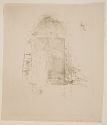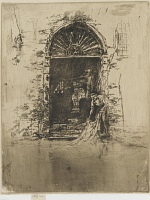Etchings Institutions search term: grolier club
The Dyer | ||
| Number: | 192 | |
| Date: | 1879/1880 | |
| Medium: | etching and drypoint | |
| Size: | 306 x 240 mm | |
| Signed: | butterfly at left | |
| Inscribed: | no | |
| Set/Publication: | no | |
| No. of States: | 10 | |
| Known impressions: | 18 | |
| Catalogues: | K.219; M.216; W.189 | |
| Impressions taken from this plate (18) | ||
STATE
Ten states are known before cancellation.
State 1

Signed with a butterfly on the wall at left, just below centre.
The composition is basically complete; scraping marks are visible near the upper corners and sides of the image.
Kennedy's image has been used for the illustration above, as the impression he reproduced has not been located. Evidence of scraping out is difficult to see on Kennedy's reproduction, but those marks are clear on the examples of the second and third states, illustrated below. 4
4: Kennedy 1910 (cat. no. 219 I).
State 2

The dyer's profile is changed, clearly defining his forehead and reducing the size of his nose; fine shading is added to the dark areas inside the doorway.
State 3

Shading is added to the dyer's left leg, and its outline is strengthened; the dyer's left foot is now fully drawn; more shading is added to the step, to left of the foot.
State 4

The dyer's left hand is now thinner and shown in a cupped position; darker shading is added to the left thigh - to right of the hand - and the lower left leg appears thinner; the dyer's right forearm and right thigh are reduced in width by new dark shading between them, and there is heavier shading immediately behind the figure; fine vertical shading is added to the fold of drapery above the dyer's right foot; short horizontal lines are added to the reflections below the dyer's left foot.
State 5

The outline of the dyer's left leg is slightly changed, restoring curves to the calf; diagonal shading on the step below the dyer's feet now extends further to the left; more horizontals are added to the reflection below the dyer's right foot.
State 7

A patch of drypoint shading is added above the dyer's head; his left arm, waist, thighs, lower left leg and left foot are redefined; the edge of the wall to left of the dyer is now darkly shaded from the dyer's waist to his ankle; some fine shading is worn, most notably on details within the open doorway.
State 8

Lines are removed or reduced around the dyer's head, creating a larger white patch to the left of it and changing the appearance of the man's profile, which now features an upturned nose; many lines that defined the dyer's left arm, right thigh, left leg and foot are removed, along with much of the shading around them; a number of short vertical lines are added to the riser of the lowest step, to left of the drapery; fine shading along the lower edge of the wall to right of the dyer is mostly removed or worn away.
State 9

The dyer, the piece of drapery and parts of the background, wall and step around them are removed; several diagonal etched lines indicate the lowest folds of the drapery; vertical, horizontal and diagonal etched lines on the water at right indicate reflections; small flecks of foul biting are present at lower left and several larger spots appear at lower right, at the base of the wall.
Between the previous state and this one, Whistler apparently replaced some earlier work with boldly etched lines and then removed all but a few of those lines, which indicate drapery folds and reflections. No impression of an intermediate stage has been located.
State 10

A new figure is added in outline, where the original dyer once stood.

However, this is the final state, as evidenced by the existing copper plate.
State 10 (cancelled)
Cancelled with one diagonal line.
No impression from the cancelled plate is known. It is known only from the cancelled plate.


